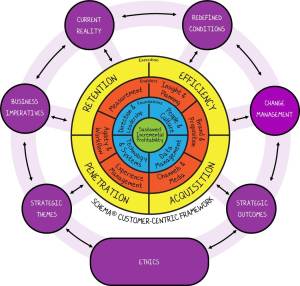Designing and executing a customer-centric business model requires end to end organisational alignment. Customer-centric capability development cannot take place in isolation to the rest of the business. The customer-centric journey requires a clear quantified understanding of current organisational capability across all 14 capability areas of the SCHEMA® Customer Management framework in the centre of the REAP Customer-Centric Blueprint below. As important as an understanding of current customer management capability is, so too is an understanding of the capability to which the organisation aspires.
Each week I’ll address another single capability area, sharing with you the Transformation Intent to which your organisation should commit to, as well as ‘What Good Looks Like’ for those organisations that have achieved a fairly high level of maturity in the respective capability area.
The REAP Customer-Centric Organisation Blueprint®
This week we are dealing with Retention which is one of the four Execution capability areas represented. The Execution layer relates to the capabilities and control levers needed to optimise customer value and include Retention, Efficiency (understanding cost to serve), Acquisition and Penetration (customer development, cross-sell and up-sell) – collectively referred to as REAP. These are capabilities and initiatives that can be optimised in the short term.
These capabilities support your ability to implement your chosen customer strategies and rely on the fundamental building blocks (Foundations) as well as the Enabling capabilities already discussed in Part 1 to 10 of this series of blog posts.
Each of the four Execution capability areas is made up of sub-components. In developing Retention capabilities it is important to understand the drivers that create and maintain loyalty as well as the factors that destroy it, important to consider how to retain through business as usual, important to consider pro-active retention activity and how to best manage dissatisfaction. Each of these areas is addressed in separate, individual blog posts.
Transformation Intent – Retention
“Retention is all about understanding your customer base and the drivers that create and maintain loyalty as well as the factors that destroy it. Coupled with this is the need to consistently deliver on your promise while ensuring that over-delivery is balanced against the overriding goal of doing just enough to ensure repurchase. A retention strategy also demands that you are pro-active with your customers, monitoring them for signs of defection and implementing constructive plans to generate customer commitment to repurchase. Should customers become dissatisfied, the right flows of communication alert you so that the issues can be addressed promptly and consistently, whilst solving the problem at a root cause level.”
What Good Looks Like – Retention through Business-as-Usual
- The organisation collects the customer data and attitudes it needs to get to know early phase customers recognising data that it had already collected during the acquisition process and may have from a previous relationship. It also makes it easy for the customers to do the same about the organisation.
- The scope ‘basic’ service delivery is defined and the effect of over/under-delivering against this is understood in terms of business value and customer attitude. This understanding is communicated internally, along with the performance of competitors in the same areas.
- The level of business-as-usual contact with customers is planned and managed to ensure it matches their needs in terms of media and frequency.
- Customer-facing (by any channel) staff are encouraged and recognised for delivering great experiences in terms of tone as well as process accuracy and actively encouraged / enabled to solve as many customer issues as possible at the first contact.
- Pricing, customer inertia and other possible exit barriers are carefully used as part of the organisation’s on-going retention activity.
For more insight into customer-centric business model innovation as well as more insight into this particular area of the REAP Customer-Centric Blueprint, please see my book “The Customer-Centric Blueprint’ – http://amzn.to/ZILg4y
Filed under: 21st Century Organisation, Best Practice, Business Models, Change Management, Competitive Advantage, CRM Models, Customer Centricity, Customer Experience, customer management, Customer Relationship Management, Customer Retention, Customer Strategy, Frameworks, Innovation, Leadership, Measurement, Sustainable Business Performance | Tagged: 21st century organisations, Big Thinking, business innovation, business performance, business strategy, capability areas, capability development, company strategy, CRM, customer centricity, customer experience management, customer opertionalisation, customer-centric business model, human-centred enterprise, Inspiration, leadership, marketing ROI, operationalising business model, organisational alignment, stakeholder centricity, stakeholder relationships, Sustainability, thinking customer |



Leave a comment